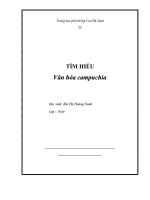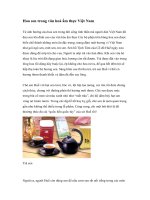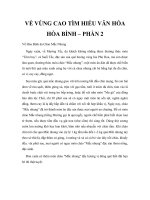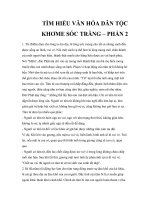Tìm hiểu văn hóa ẩm thực Nhật Bản English
Bạn đang xem bản rút gọn của tài liệu. Xem và tải ngay bản đầy đủ của tài liệu tại đây (3.86 MB, 20 trang )
Puzzle games
1 2
3
4
What's the name of this manga?
Detecve Conan
What's the name of this Sport?
Karatedo
What's the name of this song?
Doraemon
What's the name of this country?
Japan•
Japan ( 日本国 ) is an island naon in East Asia. Located in the Pacic Ocean, it lies
to the east of the Sea of Japan, China, North Korea, South Korea and Russia,
stretching from the Sea of Okhotsk in the north to the East China Sea and Taiwan in
the south. The characters that make up Japan's name means "sun-origin", which is
why Japan is often referred to as the "Land of the Rising Sun".
•
The culture of Japan has evolved greatly over the millennia, from the country's
prehistoric Jōmon period, to its contemporary hybrid culture, which combines influences
from Asia, Europe, and North America. The inhabitants of Japan experienced a long
period of relative isolation from the outside world during the Tokugawa shogunate, until
the arrival of "The Black Ships" and the Meiji period.
•
Japanese cuisine is the food—ingredients, preparation and way of eating—of Japan. The
traditional food of Japan is based on rice with miso soup and other dishes, each in its own
utensil, with an emphasis on seasonal ingredients. The side dishes often consist of fish, pickled
vegetables, and vegetables cooked in broth. Fish is common in the traditional cuisine. It is often
grilled, but it may also be served raw as sashimi or in sushi. Seafood and vegetables are also
deep-fried in a light batter as tempura.
•
Apart from rice, staples include noodles, such as soba and udon. Japan has many simmered
dishes such as fish products in broth called oden, or beef in sukiyaki and nikujaga. Foreign
food, in particular Chinese food in the form of noodles in soup called ramen and fried
dumplings, gyoza, and western food such as curry and hamburger steaks are commonly found
in Japan. Historically, the Japanese shunned meat, but with the modernization of Japan in the
1860s, meat-based dishes such as tonkatsu became common.
Japanese often pay much attention to style and very picky in food
processing.
The flavor of Japanese food is more simple than
Western food
When nished eang, they thanks again:
Sukiyaki is a family dish, reflecting the cozy gather whole family sitting around
the kitchen table for each pick up food from the pot steaming aromatic
Sukiyaki. Sukiyaki is processed at the table by cooked slices of thinly sliced
beef with vegetables, tofu and noodles.
How to make Sukiyaki?
Tempura is fried foods which are popular in Japan, we can say this is the typical dish
of the "Land of the Rising Sun". Tempura is fried dish of vegetable oil after rolling
the mixture of egg, water and flour. The composition or used as, shrimp, fish and
seasonal vegetables. To make Tempura, we often use shrimp, fish, vegetable.
How to make tempura?
There are various kinds of sushi dishes, such as nigirizushi, makizushi, chirashi. Sushi
is the most famous Japanese dish outside of Japan, and one of the most popular
dishes among the Japanese themsekves.
It is not only delicious but also very healthy.
Sashimi is thinly sliced, raw food. It is one of the most famous dishes in the Japanese
cuisine. Seafood is most commonly eaten as sashimi, but other types of meats (such
as beef, horse and deer) and foods (such as yuba tofu skin and konnyaku) can also be
served as sashimi. Some people confuse sashimi with sushi. Unlike sashimi, sushi
includes vinegared rice.
Most types of sashimi are seasoned with soy sauce by dipping each piece into a small
dish of soy sauce before eating it. It is usually the diners' responsibility to fill the
small dishes with soy sauce, and it is good manner to pour only as much soy sauce as
needed.
Depending on the type of sashimi, a little bit of wasabi or ground ginger may be
added to the sashimi piece. This is most elegantly done by dabbing the wasabi or
ginger directly onto the pieces of sashimi (as opposed to mixing it into the soy
sauce). Some people also enjoy eating the daikon and shiso garnishes; both
vegetables have a fresh, minty taste.
Yakitori are grilled chicken skewers made from bite sized pieces of meat from all
different parts of the chicken, such as the breasts, thighs, skin, liver and other innards.
Usually made to order and cooked over charcoal, yakitori is a popular, inexpensive
dish commonly enjoyed together with a glass of beer. The best yakitori is served at
specialty restaurants, known as yakitori-ya, but it can also be found at many other
types of restaurants across Japan, such as izakaya, and at festival food stands.
Osaka, where the name was invented. Its origins are traced back to the Chinese hot pot known as
shuan yang rou. Shabu-shabu is most similar to the original Chinese version when compared to
other Japanese dishes (such as sukiyaki). Suehiro registered the name as a trademark in 1955.
Together with sukiyaki, shabu-shabu is a common dish in tourist hot-spots, especially in Tokyo,
but also in local Japanese neighborhoods (often called "Little Tokyos") in countries such as the
United States and Canada.
UdonSoba
Udon are thick Japanese noodles made of wheat flour. They are thicker than soba
noodles, white and chewier. Udon is widely available at restaurants across Japan and
prepared in various hot and cold dishes. Below is a list of udon dishes that tourists will
commonly find at restaurants across Japan. Note that there are some regional
differences in terms of naming and seasoning.
1. Zaru Udon (cold)
2. Kake Udon (hot)
3. Kamaage Udon (hot)
4. Tanuki Udon (hot/cold)
5 Tempura Udon (hot/cold)
6. Curry Udon (hot)
7. Chikara Udon (hot)
8. Nabeyaki Udon (hot)
Soba noodles are noodles made of buckwheat flour, roughly as thick as spaghetti, and
prepared in various hot and cold dishes. Soba dishes are very popular and easily
available nationwide. As 100% buckwheat soba noodles tend to be brittle, many
restaurants add some wheat flour when preparing their noodles. Depending on the
shop, the percentage of buckwheat flour in soba noodles typically ranges between 40%
and 100%.
The most basic soba dish is mori soba in which boiled, cold soba noodles are eaten
with a soya based dipping sauce (tsuyu). Many soba dishes are eaten throughout the
year, while others are only available seasonally. A special kind of soba dish is
Toshikoshi Soba, a symbol of longevity, that is only eaten on New Year's Eve.
Like pasta, soba noodles are available in dried form in supermarkets, but they taste
best if freshly made by hand from flour and water. Soba making has long been a
popular hands-on activity for domestic and international travelers.
Soba can be served either hot or cold. Below are some of the more common varieties tourists will
encounter.
1. Mori/Zaru Soba (cold)
2. Kake Soba (hot)
3. Kitsune Soba (hot/cold)
4. Tanuki Soba (hot/cold)
5. Tempura Soba (hot/cold)
6. Tsukimi Soba (hot)
7. Tororo Soba (hot/cold)
8. Sansai Soba (hot)
9. Nanban Soba (hot)








